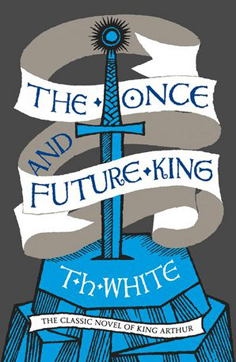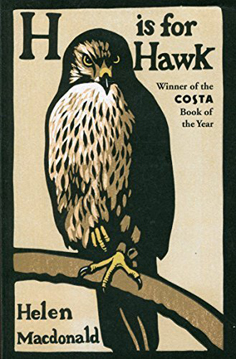I recently finished H Is for Hawk, a beautifully written book that is mostly about the author (Helen McDonald) dealing with her grief at the death of her father, by training a goshawk. Part of that story was a discussion of White's book The Goshawk, and of White in general. The time White was training his goshawk was also the time when he first started writing The Sword in the Stone, the first book of The Once and Future King. McDonald talked so much about White and of the influences in his life while writing the story that this book seemed an obvious choice for my next book. While I knew of the book already, I had always thought of it as something similar to Malory's Le Morte d'Arthur, a ‘high’ tale. But it turned out to be much more modern, very funny at times, and in part a comment on the rise of fascism in Europe in the 1930s.
I've also always thought of the story of Arthur being set just after the Romans left Britain, but White has moved the story to medieval Britain, to the time just after the Norman conquest of the Saxons. The actual Norman kings of the time are mentioned at times, but as legendary figures from mythology. The book is collection of five separate stories, spanning the full story of King Arthur.
The Sword in the Stone (first published 1938)
The first book deals mainly with Arthur's early life. Arthur, known at this time as Wart, is being raised by Sir Ector in the company of Kay (Sir Ector's son), with their tutor, Merlyn. We get to see Merlyn shaping Wart's education for his future role, mostly through various animal transformations, turning him into various creatures such as a hawk or a goose or an ant. This book culminates in Wart drawing the sword from the stone and being proclaimed king.
The Witch in the Wood (first published 1939)
The second book covers only a short time early in Arthur's reign, when he faces rebellion from a number of Scottish kings. This book is starting to become a little darker, hinting at the downfall that will eventually come. But this book also sets up Arthur's ideals, and importantly, sets up the beginnings of the new age of chivalry and the Knights of the Round Table.
The main action in this story centres on the machinations of Arthur's half-sister Morgause, and on her sons Gawaine, Agravaine, Gaheris and Gareth. This story provides the background for what will become the main source of problems for Arthur in the years ahead, the Orkney faction as Arthur later calls them. We also get an understanding of the cause of some of the problems as we get to compare Arthur's upbringing in the first story to that of the four boys in this story. Many of their future actions seem to be caused by the way they are treated by Morgause, and by the hatred she instils in each of her sons. The story ends with the incestuous conception of Mordred.
The Il-Made Knight (first published 1940)
The focus in this story shifts away from Arthur to some extent and centres mostly on Launcelot, and the story becomes even darker than the Witch in the Wood.
It was disconcerting enough to have the whole Arthuriad shifted a few centuries into the future, without having all my preconceived ideas about Lancelot destroyed. Teenage me still remembers the movie Excalibur, and more importantly, the dream scene where a naked Launcelot fights with himself. So, it was definitely a change to have his face described as ugly as a monster's in the King's menagerie
. He's meant to be the Camelot equivalent of Jaime Lannister, not an African ape
. White's Launcelot creates a very different impression to the one you get from Tennyson's The Lady of Shalott:
- His broad clear brow in sunlight glow'd;
- On burnish'd hooves his war-horse trode;
- From underneath his helmet flow'd
- His coal-black curls as on he rode,
- As he rode down from Camelot.
- From the bank and from the river
- He flash'd into the crystal mirror,
- 'Tirra lirra, tirra lirra:'
- Sang Sir Lancelot.
As White puts it near the beginning of this story, Three years of discipline made Launcelot not a merry heart and a capacity for singing tirra-lirra
.
This story is also the longest part of the book, and includes many of the major elements that are associated with the Arthurian legend - Launcelot and Guenever's love affair and lots of quests, culminating in the quest for the Holy Grail. And of course, the start of the downfall of the world Arthur has created.
Arthur's main part in this story is further developing his ideas on 'might' and 'right'. In The Witch in the Wood he started with the idea of channelling the violence of the Knights and their love of sport into chivalric ideas, of protecting the innocent, of using the 'might' for good, to 'make right'. When this ultimately brings out the worst in the Knights, he tries to turn their focus to a religious quest. And when this doesn't quite achieve what he wants, he tries to introduce civil law in the place of feudal law.
One handy part of White's story is how he provides modern analogies to explain things which may be strange to a modern reader, such as comparing Lancelot's jousting skills with that of Bradman's cricketing skills. Everyone today knows of Bradman's abilities, and his still unmatched batting record, but at the time White wrote these stories, Bradman was still playing. Here would have been an immediate identification of just how good Lancelot was, and of the years of discipline he needed to be that good.
There's a contrast between the ideals by which both Arthur and Lancelot try to live, and the reality they create instead. Arthur tries to create the best political system he can, to create a perfect world for everyone, not just the wealthy and powerful, to live in, but ultimately the system he is trying to uphold means he has to condemn his wife and best friend rather than pardoning them as he wants to.
“My laws must bind everyone, high and low, or they are not laws at all”
Lancelot dreams of being the greatest Knight and performing miracles for God, but once he believes his purity has been permanently destroyed, he gives in to his feelings and consummates his affair with Guenever. And of course, that is high treason and leads to the downfall of the man he had spent his life striving to be the greatest Knight for. The personal details I learned of White from H is for Hawk made me think that White put a lot of himself into the character of Lancelot. Like White, Lancelot is a sadist who tries to avoid hurting people. Like White, Lancelot is filled with self-loathing at times. I also think that there is a suggestion in the story that Lancelot's feelings for Arthur mirrored White’s closet homosexuality to some extent.
This story ends with Launcelot finally achieving a lifelong goal - he performs a miracle. A miracle, when he was in deep despair that he would be finally exposed as a fraud in front of everyone and revealed to not be the perfect Knight after all.
The Candle in the Wind (first published 1958)
This is the second last story in my edition, but was the final story in the original publication of The Once and Future King. My edition also includes The Book of Merlyn which White intended to be published with the other four books but was originally left out by the publisher. So, originally this is the story which finally brought all the storylines together for readers and wrapped up the tale of Arthur, Launcelot and Guenever.
Mordred and Agravaine plot to publicly reveal Launcelot and Guenever’s love affair to the King leads to war after war after war until the final showdown between Mordred and Arthur. This is only a short book, with all of the conflicts economically described, in contrast to the very drawn out Ill-Made Knight.
The Book of Merlyn
The final book picks up immediately at the end of The Candle in the Wind, with Arthur alone on the night before the final battle with Mordred. After many years of absence, Merlyn reappears to take Arthur off for the night, for a final round of lectures on the nature of Man and of the wickedness of war.
I think I’m actually in agreement with the publishers, The Candle in the Wind, with perhaps parts of the final chapter of The Book of Merlyn as an afterward, seem to me to be a better way to end the story. Merlyn’s lecturing and hectoring of Arthur seem out of place after the beautiful ending of The Candle in the Wind with Arthur accepting the inevitability of his death in the battle that will come with the dawn. This story is the reason my rating drops down to 4.5 stars. Without it I think the book would be a 5 star book.
It is obvious when reading the whole story, but especially the last two books, that it was written in the 1930s and 1940s, when fascism was on the rise in Europe. I recently read an article on the current rise of fascism across the world which talked about Oswald Mosley and his Blackshirts in England in the 1930s. The descriptions of the Blackshirts could easily be the descriptions of Mordred’s Thrashers.
The conflict in Arthur at the end, when he tries to work out why men fight, seems to have echoes in White’s own conflicted feelings over the war he knew was coming, and which led him to leave England and spend the war years in Ireland as a conscientious objector.
The idea of ‘might’ versus ‘right’ is there in the first story, but it develops much further in each subsequent story. The tone starts of fairly light-hearted, with a lot of fantasy, and the amusing side story of Sir Pellinore and his Questing Beast, but gradually gets darker as the story progresses, until we finally get to the tragic end of the story with The Candle in the Wind. It’s a huge book, but one that is easy to read, if you have the time to read it without interruption. I didn’t have this uninterrupted reading time, and had to keep on picking up where I was in the story. Despite this problem, I loved almost all of this book except for the last story which I thought was a letdown after the beautiful ending of The Candle in the Wind. Highly recommended.

 RSS Feed
RSS Feed Facebook
Facebook Instagram
Instagram YouTube
YouTube Subscribe to our Newsletter
Subscribe to our Newsletter



No one has commented yet. Be the first!